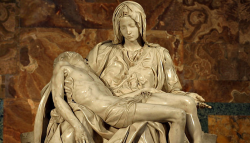The Florentine building known as Orsanmichele was one of the most important places for sculpture in the early Renaissance years. Built in 1337, it was used to store grain and was owned by the city. Its name was derived from an oratory dedicated to St. Michael that had previously occupied the site as early as the ninth century. The oratory was located within a garden, and its full name was San Michele in Orto, which was eventually condensed to Orsanmichele.
The fourteenth-century Orsanmichele granary became an important artistic battleground where the guilds would compete. Each guild, which formed around a particular trade or profession, adopted its own patron saint and was therefore a quasi-religious body. The city of Florence gave the guilds the rights to install statues of their patron saints in the niches which were around the outside of the building near street-level. These would have been highly-visible places for public viewing of the guild statues.
The guilds were responsible for commissioning the works (and paying for them) that would be placed in the Orsanmichele niches. For whatever reason, however, they were slow to hire sculptors and the niches remained unfilled for some time. Because of this, around 1407 the government of Florence passed a law stating that if the guilds did not install a statue in their respective niches within ten years from that date, they would lose the right to their niche.It is after this point in time that we see a flurry of activity by the guilds to commission works for the Orsanmichele niches. Some of the artists who were commissioned were Donatello, who carved a marble statue of St. Mark and one of St. George; Nanni di Banco, who carved the Four Crowned Saints (otherwise known as the Quattro Santi Coronati); and Lorenzo Ghiberti, who cast bronze works of St. Matthew and St. John the Baptist.
Further Reading
Orsanmichele a Firenze. Edited by Diane Zervas. Modena: F.C. Panini, 1996.





